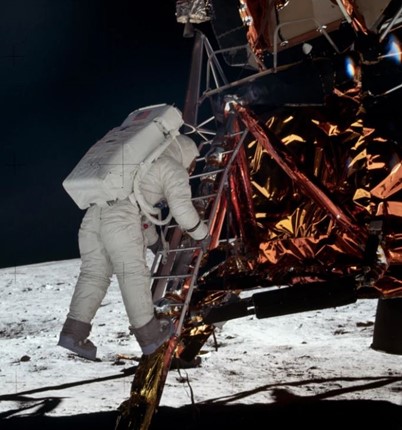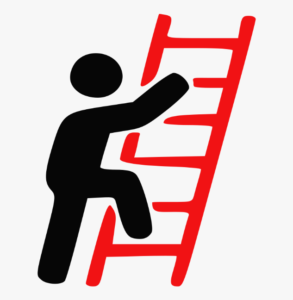Ladders…not a particularly exciting topic I’ll admit. But hey, we need ladders to help us accomplish all kinds of tasks. Most people have used at least one of the many types of ladders that are available today. And the odds are probably pretty good that many of those users strayed outside the limits of safety a time or two while on a ladder. It is amazing the risks some people will take to save some time or avoid the inconvenience of getting down to move the ladder into a safer position. I wonder how many of those risks would be taken on a ladder if the users knew they were on camera.
Think about astronaut Neil Armstrong. He travelled by rocket almost 239,000 miles through space and has just successfully landed the lunar module on the surface of the moon. Quite an accomplishment! Now, with the eyes of the world on him, he is going to come down a ladder and become the first person to set foot on the moon. I wonder how many times Neil Armstrong practiced coming down that ladder. Now imagine him saying during that historic moment: “That’s one small step for a man… one giant leeee….aaaaaahhhhhhh!” And then the world watches as he falls back off the ladder and comes to rest lying on his back….on the surface of the moon….with a broken leg, a sprained wrist, and a bruised back, and clutching a ladder rung in one of his hands! And 239,000 miles from the nearest Urgent Care!

Image Credit: NASA Archives
That would have drastically changed everything about the overall mission of the astronauts! The investigation into this ladder accident would be an interesting and important one for sure, and the fact that such strong evidence was caught on video would be a luxury not usually available to the investigator. Well, fortunately that accident did not happen! Neil Armstrong finished his famous quote, he successfully stepped off the lunar module ladder, and the overall mission of the Apollo 11 flight was incredibly successful.
Obviously, the everyday use of ladders at factories and homes across the U.S. lacks the drama and suspense of a moon mission ladder descent, but there are some similarities that we can look at. Using a ladder always involves a level of risk. That risk level is dependent on things such as the type of ladder, the height climbed, the attention of the user to follow all ladder safety rules, as well as the design and stability of the ladder used. Ladders that are available these days are typically safe with respect to their design and the materials they are constructed of. However, statistics show that in the US, on average, work-related ladder falls result in one death and more than 180 nonfatal injuries every two days. In some of these cases, questions are raised about what actually caused or contributed to the accident. When this happens, it is common for a forensic engineer to be hired to investigate the accident to determine if there was a defect in the ladder’s design or the materials it was manufactured from, or if the user of the ladder was possibly at fault.
 The things a forensic engineer will consider in the investigation are dependent on the specific circumstances of each accident as well as the scope of the accident request. Typically, the type of ladder and whether it adhered to the design standards that were in place when it was manufactured will be a part of the investigation. A quick internet search will show whether there are or have been recalls for that particular ladder model. A thorough study of the ladder, whether through quality photos or having the actual ladder involved in the accident, can reveal evidence that will show whether a defect was present in the ladder at the time of the accident. The specific members that were damaged can sometimes show how the ladder was loaded when it failed, and whether that failure may have been due to either a defect or the user’s bad judgment. The goal of the investigation will be to find the truth as to what happened and to give a concise explanation of the expert’s findings along with his /her opinions in the final report.
The things a forensic engineer will consider in the investigation are dependent on the specific circumstances of each accident as well as the scope of the accident request. Typically, the type of ladder and whether it adhered to the design standards that were in place when it was manufactured will be a part of the investigation. A quick internet search will show whether there are or have been recalls for that particular ladder model. A thorough study of the ladder, whether through quality photos or having the actual ladder involved in the accident, can reveal evidence that will show whether a defect was present in the ladder at the time of the accident. The specific members that were damaged can sometimes show how the ladder was loaded when it failed, and whether that failure may have been due to either a defect or the user’s bad judgment. The goal of the investigation will be to find the truth as to what happened and to give a concise explanation of the expert’s findings along with his /her opinions in the final report.
If you need an investigation of an accident involving any type of ladder, please call our experienced mechanical engineering experts at Warren.
Bob Hickman is a Licensed Professional Engineer and Certified Machinery Safety Expert. He has over 30 years of manufacturing and machine design experience in production and quality-driven environments. Bob holds a Bachelor of Science in Mechanical Engineering from Clemson University. Over his 30-year engineering career, Bob has designed many custom manufacturing machines and processes that improved quality, productivity, reliability, and safety. He designed several machines to automate manual processes, replacing inefficient/unreliable manual equipment and has assisted with plant layout/production line planning. He has significant experience with pneumatic systems and components, as well as hydraulics. Bob regularly investigates personal injury, wrongful death, and product liability claims, as well as property damage claims involving machinery and equipment in a variety of environments for both insurance adjusters and attorneys. Bob has an in-depth knowledge of many standards with emphasis on ANSI B11 standards for machine tool safety.



